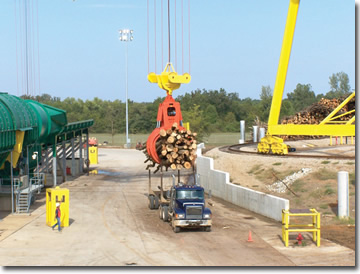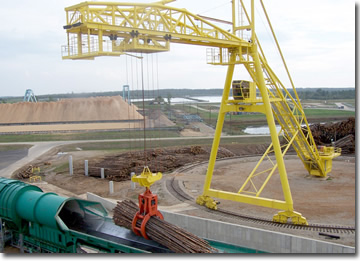Back Issues
|
 |
|
Wood biomass from forestry operations represents part of the two billion tons of biomass generated on an annual basis in the United States, which could be used in energy or ethanol production. |
"The average landowner is probably around 70 years old, and that land is a very personal thing to him," says Carmical. It may have been in the family for generations. "They are going to be extremely protective of it, expecting you to do a good job when you are there." Earning the trust of potential raw material suppliers is critical because developers will want to go back to them at some point to maintain a consistent flow of reasonably priced raw material.
Having a guaranteed supply of raw material not only factors into the viability of a plant, but also for securing investment capital. There must be enough raw material within a defined radius of a facility and long term supply contracts in place before most investors will fund a project. Otherwise, a project is dead in the water.
When U.S. President Barack Obama speaks about investments in alternative energy development-and its potential to also fuel business opportunities and create jobs-he likely had in mind businesses like the Price BIOstock division of The Price Group of Companies in Arkansas. That's because the company knows biomass and where to find it. It's also one of the few companies in the U.S. with the capability of conducting the initial legwork to contact biomass suppliers, evaluating their willingness to sign supply contracts, and arranging for the proper permits. They can also design, build, and operate the processing facility, ensuring that Price BIOstock can deliver a biomass price to their client.
"What has worked for us is that, to some degree, we are national in scope and scale," says Carmical. Yet, he adds, they are still kind of a "blue collar, muddy boot outfit" that does business differently than a large publicly-traded company. "I think that we keep an appreciation of the individual landowner's concerns."
Price BIOstock gains from its 44 years of experience in the wood industry, primarily as a provider of wood chips and hog fuel to many leading companies in the pulp and paper industry. They operate 19 Price-designed chipping mills under contract for companies in the United States and Australia.
In 2006, they started offering their services to locate sources of biomass, organize procurement, help in the design of a plant's onsite biomass inventory and processing, and manage delivery of the type of product needed for conversion technology to work at optimum output.
Energy companies looking to convert from coal to biomass
In addition to the new biomass to energy plants, a number of power utilities are looking at converting from traditional energy sources, such as coal, to biomass. FirstEnergy Corp. recently announced the company would invest $200 million to repower two units at its coal-fired Burger Plant along the Ohio River, to transition to renewable biomass fuel. And in the south, the Georgia Public Service Commission has given Southern Co.'s largest utilities provider, Georgia Power, the green light to go ahead with the conversion of its coal-fired power plant near Albany, Georgia, to a 100-percent wood-fired biomass plant.
The lack of investment capital, more than the current cheaper price for fossil fuels, is what is slowing further development of the alternative fuels industry, says Carmical.
He believes that all the ethanol market really needs now is the right combination of government support for guaranteed fuel purchase, increased public concern over global warming, and higher prices for fossil fuels to ignite a gold rush-type mentality for biomass in a variety of forms.
While Carmical describes himself as a strong supporter of free enterprise, he believes a commitment from a large organization like the Department of Defense to purchase all the ethanol from a facility at a specified rate, and indexed to protect the producer, would send a strong message of support for the industry-especially to investors. This would help to counteract actions taken by organizations aimed at undercutting the growth of the alternative fuels industry.
"I think we are at a very interesting time because all we need right now is for one process to come online, on a commercial scale basis, and be successful," he says. "I think we are going to see the biggest land rush for these facilities since the Oklahoma Territory was opened up for settlement. Once we create a market, we will see that we have the ability to grow new products, to utilize land presently not in production, and find more efficient ways to harvest and gather. We will exceed our expectations of how much product we are going to be able to produce."
Carmical believes that forestry residue represents the lowest hanging fruit in terms of biomass sources.
"When you get down to it, my feeling is that this is mostly going to be a logistics issue of spending the least amount of money getting the product in the gate," he says. "That means you need something that is energy-dense, requires the least amount of freight, is available round-the-clock, 365 days a year, where you don't have to get into big issues like inventory and re-handling, and that lends itself to single pass harvesting. All this that I am describing is forestry."
Carmical adds that the forest industry has already addressed many of the issues related to sustainability that would typically be raised by the environmental community when it comes to producing ethanol or energy from forest residues, because those issues were dealt with when the pulp and paper industry was established. The management practices to ensure sustainability are in place.
"The good news is that we won't have to re-invent the wheel," says Carmical.
Price BIOstock becomes involved in a project in one of two ways-either they know of a potential biomass resource and approach a potential developer, or the company is approached by potential investors looking for a large and sustainable raw material source. Usually, it's the latter.
Carmical emphasizes that the company makes no judgement on the choice of conversion technology. All they attempt to do is match the raw material needs to the customer. Sometimes the customer already has a location in mind. Price BIOstock also has the ability to steer them to particular regions where the company is aware of potential opportunities. Once the client has made a decision on the desired feedstock and a potential location, Price BIOstock will conduct an investigation on the availability of the raw material and how much it will cost the customer.
Carmical says that there is probably a lot more biomass out there than people realize. According to the Billion Ton Biomass Study conducted by the U.S. Forest Service and Department of Agriculture, it was determined that the United States has enough biomass to provide at least 25 percent of the fuel needs of the country, as well as 30 percent of its industrial chemicals, and five percent of its electrical power.
And that may be understating the figures. "Personally, I think it is even greater than that," says Carmical.
May/June 2009




 There's no doubt that the potential for energy produced from biomass is huge. The U.S. Department of Energy estimates that over two billion tons of biomass is available each year from forestry, agriculture, and urban sources in the United States, which could be used as raw material to generate clean energy and bio-products.
There's no doubt that the potential for energy produced from biomass is huge. The U.S. Department of Energy estimates that over two billion tons of biomass is available each year from forestry, agriculture, and urban sources in the United States, which could be used as raw material to generate clean energy and bio-products.



